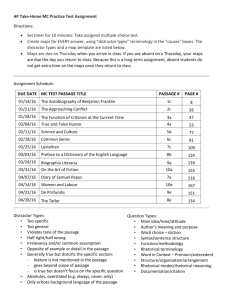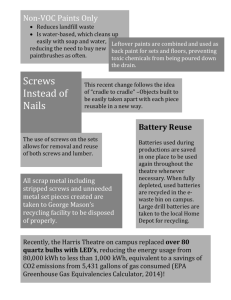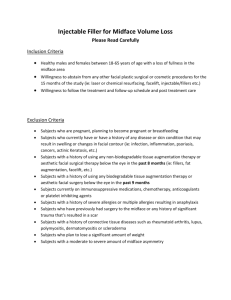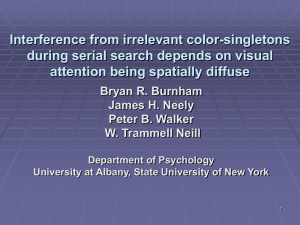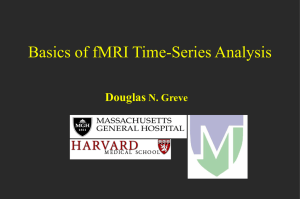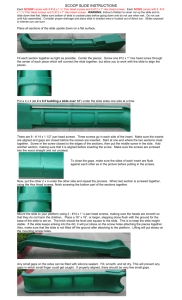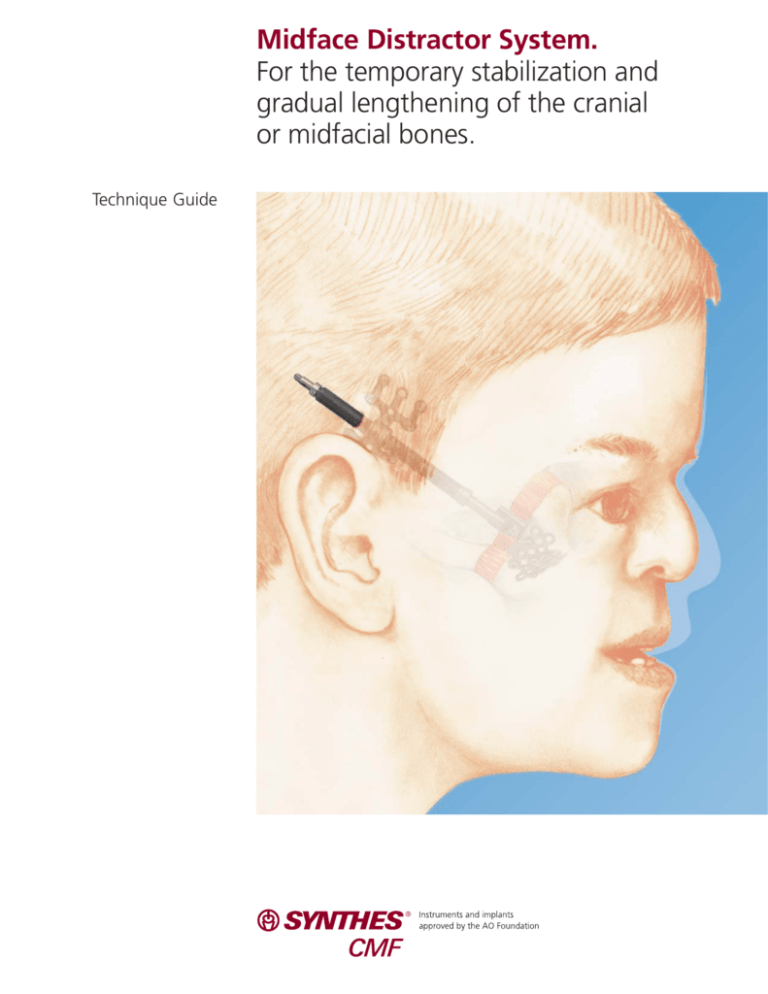
Midface Distractor System.
For the temporary stabilization and
gradual lengthening of the cranial
or midfacial bones.
Technique Guide
Table of Contents
Introduction
Surgical Technique
Product Information
Midface Distractor System
2
Indications
2
Distractor Assembly
3
Device Placement
6
Postoperative Considerations
13
Consolidation
14
Device Removal
15
Anterior Footplate Options
16
Activation Arm Extension Options
18
Instruments
19
Set List
21
Synthes
Midface Distractor System. For the temporary stabilization and gradual
lengthening of the cranial or midfacial bones.
Features
– Telescoping design utilizes internal distraction mechanism
– Multiple anterior footplate designs for a wide range of
placement options
– Posterior footplate allows variable positioning in the
temporal region
– Optional activation arm extensions to fit patient’s anatomy
– System allows up to 40 mm of distraction
– Distractor bodies and footplates are made of Ti-6Al-7Nb
– For use with 1.5 mm titanium screws
– System designed for use with Synthes Titanium
Contourable Mesh
Anterior footplate features
– The plates with buttress can be used to push the bone
segment forward, thus sharing the load of distraction with
the screws.
– Symmetrical footplates permit the distractor to be angled
for a downward distraction vector.
– Offset footplates permit the distractor to be placed on
a vector parallel with the occlusion for a horizontal
distraction vector. The buttress on these footplates
should sit flush against the bone for adequate stability.
Posterior Foot
1.2 mm Machine Screw
Activation
Hex
Distractor Body
Distractor Nut
Indications
For use in adult and pediatric patients for the treatment
of cranial or midface conditions for which reconstructive
osteotomy and segment advancement are indicated,
including conditions such as syndromic craniosynostosis
and midface retrusion.
The device is intended to provide temporary stabilization
and gradual lengthening of the cranial or midfacial bones.
2
Synthes Midface Distractor System Technique Guide
Anterior Foot
Distractor Assembly
1
Assemble the distractor nut
Thread the distractor nut onto the distractor body.
2
Assemble the posterior footplate
Thread the posterior footplate onto the distractor body.
The posterior footplate can be adjusted in 0.5 mm increments
along the distractor body to best fit the patient’s anatomy.
Technique tips: Once the posterior footplate location is
determined, finger-tighten the distractor nut against the
posterior footplate for stabilization.
A second posterior footplate can be threaded onto the
distractor body to add stability to the device assembly.
Assembly shown is for patient’s left side.
Synthes
3
Distractor Assembly
3
Attach the anterior footplate
Choose the anterior footplate that best suits both the anatomy
of the patient and the treatment plan. Refer to pages 15 –16
of this technique guide for footplate options.
Instruments
311.005
Handle, with hex coupling, small
313.837
1.5 mm Screwdriver Blade, self-retaining,
StarDrive
Engage the distractor body into the “slip-fit” of the anterior
footplate. Insert the 1.2 mm machine screw to affix the anterior
footplate to the distractor body.
Note: If the 1.2 mm machine screw is not used, the
distractor body may be removed after consolidation, without
a coronal incision. (This will leave the anterior footplates on
the zygoma.)
Warning: If the 1.2 mm machine screw is not used, extra
care should be taken to not reverse the distractor during
distraction, as it can inadvertently disengage from the
anterior footplate.
Attaching the contourable mesh to the anterior footplate
1. Place the 1.5 mm titanium contourable mesh plate over
the anterior footplate for mesh.
2. Align the three holes in the anterior footplate for mesh
with the three screw holes on the edge of the 1.5 mm
titanium contourable mesh plate.
3. Ensure the screw hole countersinks on the 1.5 mm
titanium contourable mesh plate are facing upward.
4. Insert three 1.2 mm machine screws to affix the two
plates together.
Notes: Larger sizes of the 1.5 mm titanium contourable mesh
plates are available if necessary for proper screw placement:
70 mm diameter (446.054), 100 mm diameter (446.055).
The footplates for mesh require reducing the lateral surface
of the zygoma with a burr to allow the contourable mesh
to sit flush against the bone. Screws must be placed in the
holes closest to the foot for adequate device stability.
Assembly shown is for patient’s left side.
4
Synthes Midface Distractor System Technique Guide
Optional
Attach activation arm extensions
If necessary, attach an activation arm extension to the
distractor body to allow the activation hex to protrude
through the soft tissue for activation.
Choose the activation arm extension that best suits the
patient. Refer to page 17 of this technique guide for
activation arm extension options. Engage the activation
arm extension with the distractor body by slipping it over
the activation hex.
Secure the activation arm extension to the distractor body
with the 1.2 mm machine screw. Be sure to fully tighten
the screw.
Note: For smaller patients, the distractor body length may
be sufficient for percutaneous activation.
Repeat Steps 1–3 for the opposite side.
Assembly shown is for patient’s left side.
Synthes
5
Device Placement
The footplates can be contoured to the patient’s anatomy,
on a 3-D anatomical model prior to surgery, or on the
patient intraoperatively. If contouring the footplates
intraoperatively, follow the surgical technique below.
1
Fit the distractor
Place a fully assembled distractor in the intended placement
area to assess the bony anatomy and to determine approximate
anterior and posterior footplate locations.
Reminder: Determine if the activation arm extension(s)
are necessary for the activation hex to exit through the
soft tissue for activation.
Technique tip: It is recommended to place the distractor
under the temporalis muscle when determining final
placement.
6
Synthes Midface Distractor System Technique Guide
2
Contour the footplates
Instruments
347.964
Combination Bending Pliers (2 required)
391.952
391.990
Mesh Cutter or
Plate and Rod Cutter
Contour the anterior and posterior footplates using the
combination bending pliers. Undesired screw holes may be
removed using the mesh cutter or the plate and rod cutter.
Each footplate should contain a minimum of four screws
for adequate stability.
Technique tips: The anterior footplates should span the
zygomaticomaxillary sutures to ensure the maxilla advances
with the rest of the midface.
Placement of the footplates determines the advancement
vector of distraction and should be aligned with advancement
vectors determined during preoperative planning.
Caution: Repeat bending may damage the footplates and
cause implant failure.
Synthes
7
Device Placement
3
Mark the distractor location
Instruments
311.005
Handle, with hex coupling, small
313.254
1.5 mm / 2.0 mm Screwdriver Blade,
self-retaining, PlusDrive, hex coupling,
52 mm
Mark the distractor location prior to the down fracture by
inserting two appropriate length screws through the anterior
footplate and one appropriate length screw through the
posterior footplate.
Fully tighten the screws in the anterior footplate but do
not tighten the screw in the posterior footplate.
Technique Tip: Placing screws in the posterior footplate may
not be preferable at this time. Instead, mark the location of
the footplate with a marking pen.
Note: Drilling a pilot hole with a 1.1 mm drill bit is necessary
when using 1.5 mm self-tapping screws.
Cautions: Bone screws should be placed in areas of hard
cortical bone to provide stable fixation. Screws can loosen
during the course of treatment if placed in poor quality
bone.
Drill rate should never exceed 1800 RPM. Higher rates can
result in thermally generated necrosis of the bone, and an
oversized hole to be drilled. The detriments of an oversized
hole include reduced pullout force, increased ease of screws
stripping in bone, and/or suboptimal fixation. Always irrigate
during drilling.
Repeat Steps 1–3 on the contralateral side.
8
Synthes Midface Distractor System Technique Guide
4
Remove the distractors
Instruments
311.005
Handle, with hex coupling, small
313.837
1.5 mm Screwdriver Blade, self-retaining,
StarDrive
Remove the distractors by unscrewing the 1.2 mm machine
screws and the posterior footplate screws.
The anterior footplates can stay on the zygomas.
This will help realign the devices after the down fracture.
Technique tip: If desired, the anterior footplates can be
removed with the distractor bodies prior to the down fracture.
5
Perform the down fracture
Perform the down fracture and ensure the midface segment
is completely mobile.
Important: The midface must be completely mobile as the
distractors are not intended to complete the osteotomy.
Synthes
9
Device Placement
6
Reattach the distractors
Instruments
311.005
Handle, with hex coupling, small
313.837
1.5 mm Screwdriver Blade, self-retaining,
StarDrive
313.254
1.5 mm / 2.0 mm Screwdriver Blade,
self-retaining, PlusDrive, hex coupling,
52 mm
Once the midface is completely mobile, reattach the distractors
by re-engaging the distractor bodies with the “slip-fit” of each
anterior footplate.
Insert the 1.2 mm machine screws to lock the anterior
footplates and distractor bodies together. Reinsert the screws
in the posterior footplates, in the previously marked locations.
Drill and/or insert appropriate length screws in the anterior
and posterior footplates. Fully tighten all screws.
10
Synthes Midface Distractor System Technique Guide
Notes: A minimum of four screws should be placed
in each footplate for adequate stability. If necessary, activation
arm extensions can be added to lengthen the distractors for
activation.
Drilling a pilot hole with a 1.1 mm drill bit is necessary when
using 1.5 mm self-tapping screws.
Technique tip: When using the 1.5 mm contourable mesh
plate, the screw holes closest to the anterior footplate for
mesh should contain bone screws. This will ensure stable
fixation for distraction.
Cautions: Bone screws should be placed in areas of hard
cortical bone to provide stable fixation. Screws can loosen
during the course of treatment if placed in poor quality
bone.
Drill rate should never exceed 1800 RPM. Higher rates can
result in thermally generated necrosis of the bone, and an
oversized hole to be drilled. The detriments of an oversized
hole include reduced pullout force, increased ease of screws
stripping in bone, and/or suboptimal fixation. Always irrigate
during drilling.
Synthes
11
Device Placement
7
Confirm device stability and activation
Instruments
314.402
Activation Instrument
395.35
Combination Wrench, 7 mm width
across flats
Tighten the distractor nuts against the posterior footplates
using the combination wrench.
Using the activation instrument, turn each distractor in a
counterclockwise direction, as marked on the instrument’s
handle, to confirm the stability and verify the movement of
the midface.
The midface should advance upon activation of the
distractors. Before closure, return each distractor to its
original position.
Warning: If the 1.2 mm machine screws were not used to
lock the anterior footplates to the distractor bodies, ensure
the two components are fully engaged when the devices are
returned to their original position.
12
Synthes Midface Distractor System Technique Guide
Postoperative Considerations
1
Suggested distraction protocol
Instrument
314.402
Activation Instrument
Distraction should begin three to five days after device
placement. To achieve lengthening, engage the activation hex
with the activation instrument and rotate counterclockwise
(in the direction of the arrow marked on the instrument).
A rate of 1.0 mm of distraction per day is recommended to
prevent premature consolidation. Each full rotation equals
0.5 mm of distraction.
Warning: The devices are capable of 40 mm of distraction
(80 counterclockwise rotations). Distraction beyond this limit
will cause the devices to separate.
2
Patient care
To avoid the accretion of dried blood to the device, a regimen
of applying antibiotic ointment to the percutaneous port is
recommended throughout the course of distraction.
Upon the first activation, special care should be given
to ensure that the activation hex is free from soft tissue
adhesion. Similar care should be given to all subsequent
activations to provide the most comfort for the patient.
Keeping the hair short around the activation port can also
be beneficial to the patient’s comfort during distraction.
Care should be taken to protect the distractors during
treatment to prevent them from being damaged and disrupting
treatment and/or causing the patient pain or injury.
Synthes
13
Postoperative Considerations
3
Document progress
Distraction progress should be observed by documenting the
movement of the infraorbital rim and anterior maxillary
teeth. A Patient Care Guide is included with the activation
instrument to help record and monitor distraction progress.
Consolidation
After the desired advancement has been achieved, the new
bone must be given time to consolidate. The consolidation
period should be at least six to eight weeks. This time period
may vary in relation to the patient’s age. Adequate bone
consolidation can be confirmed by manually verifying
midface stability.
14
Synthes Midface Distractor System Technique Guide
Device Removal
If 1.2 mm machine screws were used:
Instruments
311.005
Screwdriver Handle, with hex coupling,
small
313.254
1.5 mm/2.0 mm Screwdriver Blade, selfretaining, PlusDrive, hex coupling, 52 mm
If the 1.2 mm machine screws were used to lock the anterior
footplates to the distractor bodies, it will be necessary to
gain access to the screws in the anterior and posterior
footplates for device removal.
If 1.2 mm machine screws were not used:
Instruments
311.005
Screwdriver Handle, with hex coupling,
small
313.254
1.5 mm/2.0 mm Screwdriver Blade, selfretaining, PlusDrive, hex coupling, 52 mm
314.402
Activation Instrument
If the 1.2 mm machine screws were not used, it is possible
to remove the devices without gaining access to the anterior
footplates. Using the activation instrument, turn each
distractor clockwise (in the opposite direction of the arrow
marked on the activation instrument) at least 20 times to
disengage the distractor bodies from the anterior footplates.
Make an incision over each posterior footplate to gain access
to the screws. Remove all screws in the posterior footplates
and lightly pull the distractor bodies through the incisions,
leaving the anterior footplates on the zygomas.
Technique tip: For screw removal options use the Synthes
Universal Screw Removal Set (01.505.200)
Synthes
15
Anterior Footplate Options
Anterior foot, elevated, right (487.984), left (487.985)
Screw holes on these footplates are offset from the distractor
body. This allows the distractor to be placed more in line
with the vector of the occlusion, and to allow the placement
of screws lower on the zygoma. The buttress acts as an
aid to push the midface segment forward, sharing the load
of distraction with the screws.
Note: The buttress on these footplates should sit
flush against the bone for adequate stability.
Right–487.984
Left–487.985
Anterior foot, low profile, symmetrical (487.986)
Screw holes on the footplate are symmetrical with the
distractor body. This allows the distractor to be placed on
an angle to achieve a downward vector of distraction.
Engagement of the distractor body and the anterior footplate
occurs on the medial side of the anterior footplate, making
the distractor assembly lower profile in the lateral
orbital region.
16
Synthes Midface Distractor System Technique Guide
Anterior foot, elevated, symmetrical (487.987)
Screw holes on the footplate are symmetrical with the
distractor body. This allows the distractor to be placed
on an angle to achieve a downward vector of distraction.
487.987
Anterior foot, for mesh (487.988)
The footplate allows use of the 1.5 mm titanium
contourable mesh plate.
487.988
Anterior foot, for mesh, with buttress (487.989)
The footplate allows use of the 1.5 mm titanium
contourable mesh plate. The buttress acts as an aid
to push the midface segment forward, sharing the
load of distraction with the screws.
Note: The buttress on these footplates should sit
flush against the bone for adequate stability.
487.989
Synthes
17
Activation Arm Extension Options
487.992
Titanium Rigid Extension, 20 mm length
487.993
Titanium Universal Joint Extension,
20 mm length
487.994
Flexible Cable Extension, 40 mm length
L-605 Cobalt chromium alloy cable,
with silicone tubing
18
Synthes Midface Distractor System Technique Guide
Instruments
311.005
Screwdriver Handle, with hex coupling,
small
313.254
1.5 mm/2.0 mm Screwdriver Blade, selfretaining, PlusDrive, hex coupling, 52 mm
313.837
1.5 mm Screwdriver Blade, self-retaining,
StarDrive, hex coupling
314.402
Activation Instrument
1.1 mm Drill Bits, Stryker J-latch
317.14
317.16
317.18
4 mm stop
6 mm stop
8 mm stop
Synthes
19
Instruments
347.964
Combination Bending Pliers
391.952
Mesh Cutter
391.990
Plate and Rod Cutter
395.35
Combination Wrench, 7 mm width
across flats
20
Synthes Midface Distractor System Technique Guide
Midface Distractor Set (145.955)
Cases and Lids
304.686
Universal Instrument Tray
304.687
Universal Instrument Tray Lid
304.797
Titanium Midface Distractor Module Case
Screw Length Markers
304.104
4 mm, 1 pkg. of 10
304.106
6 mm, 1 pkg. of 10
304.108
8 mm, 1 pkg. of 10
304.104W
For self-drilling screws, 4 mm, 1 ea.
304.106W
For self-drilling screws, 6 mm, 1 ea.
304.108W
For self-drilling screws, 8 mm, 1 ea.
Instruments
311.005
Screwdriver Handle, with hex coupling,
small, 2 ea.
313.254
1.5 mm / 2.0 mm Screwdriver Blade,
self-retaining, PlusDrive, hex coupling,
52 mm
313.837
1.5 mm Screwdriver Blade, self-retaining,
StarDrive, 2 ea.
314.402
Activation Instrument, 2 ea.
317.14
4 mm stop
317.16
6 mm stop
317.18
8 mm stop
347.964
Combination Bending Pliers, 2 ea.
391.952
Mesh Cutter
391.990
Plate and Rod Cutter
395.35
Combination Wrench, 7 mm width
across flats, 2 ea.
1.1 mm Drill Bits, Stryker J-latch, 2 ea.
Note: For additional information, please refer to package insert.
For detailed cleaning and sterilization instructions, please refer to
http://www.synthes.com/sites/NA/MedicalCommunity/Pages/Cleaning_and_Steriliza
tion.aspx
or to the below listed inserts, which will be included in the shipping container:
– Processing Synthes Reusable Medical Devices — Instruments, Instrument Trays
and Graphic Cases — DJ1305
– Processing Non-sterile Synthes Implants — DJ1304
Synthes
21
Midface Distractor Set (145.955)
Implants
1.5 mm Titanium Cortex Screws,
self-tapping, PlusDrive, 4 pkg. of 5
446.053
1.5 mm Titanium Contourable Mesh Plate,
rigid, 30 mm diameter, 6 ea.
487.980
Titanium Midface Distractor Nut,
7 mm hex, 8 ea.
400.034
4 mm
400.036
6 mm
487.982
Titanium Midface Distractor Assembly,
40 mm length, 4 ea.
400.038
8 mm
Titanium Midface Distractor Anterior
Footplates
487.984
Elevated, right, 2 ea.
487.985
Elevated, left, 2 ea.
487.986
Low profile, symmetrical, 4 ea.
1.5 mm Titanium Cortex Screws,
self-drilling, PlusDrive, 4 pkg. of 5
400.054
4 mm
400.056
6 mm
400.058
8 mm
487.987
Elevated, symmetrical, 4 ea.
|2.0 mm Titanium Emergency Screws,
487.988
For mesh, 4 ea.
PlusDrive, 2 pkg. of 5
487.989
For mesh, with buttress, 4 ea.
487.990
Titanium Midface Distractor Posterior
Footplate, single vector, 4 ea.
487.992
Titanium Rigid Extension, 20 mm, 4 ea.
487.993
Titanium Universal Joint Extension, 20 mm,
4 ea.
487.994
Flexible Cable Extension, 40 mm, 4 ea.
487.995
1.2 mm Titanium Machine Screw, for
Midface Distractor, 12 ea.
22
Synthes Midface Distractor System Technique Guide
400.274
4 mm
400.276
6 mm
400.278
8 mm
Also Available
446.054
1.5 mm Titanium Contourable Mesh Plate,
rigid, 70 mm diameter
446.055
1.5 mm Titanium Contourable Mesh Plate,
rigid, 100 mm diameter
Synthes CMF
1302 Wrights Lane East
West Chester, PA 19380
Telephone: (610) 719-5000
To order: (800) 523-0322
Fax: (610) 251-9056
© 2003 Synthes, Inc. or its affiliates. All rights reserved.
Synthes (Canada) Ltd.
2566 Meadowpine Boulevard
Mississauga, Ontario L5N 6P9
Telephone: (905) 567-0440
To order: (800) 668-1119
Fax: (905) 567-3185
PlusDrive and Synthes are trademarks of Synthes, Inc. or its affiliates.
www.synthes.com
Printed in U.S.A. 11/11 J4348-B


